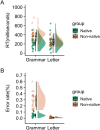Neural underpinning of Japanese particle processing in non-native speakers
- PMID: 36335170
- PMCID: PMC9637203
- DOI: 10.1038/s41598-022-23382-8
Neural underpinning of Japanese particle processing in non-native speakers
Abstract
Grammar acquisition by non-native learners (L2) is typically less successful and may produce fundamentally different grammatical systems than that by native speakers (L1). The neural representation of grammatical processing between L1 and L2 speakers remains controversial. We hypothesized that working memory is the primary source of L1/L2 differences, by considering working memory within the predictive coding account, which models grammatical processes as higher-level neuronal representations of cortical hierarchies, generating predictions (forward model) of lower-level representations. A functional MRI study was conducted with L1 Japanese speakers and highly proficient Japanese learners requiring oral production of grammatically correct Japanese particles. We assumed selecting proper particles requires forward model-dependent processes of working memory as their functions are highly context-dependent. As a control, participants read out a visually designated mora indicated by underlining. Particle selection by L1/L2 groups commonly activated the bilateral inferior frontal gyrus/insula, pre-supplementary motor area, left caudate, middle temporal gyrus, and right cerebellum, which constituted the core linguistic production system. In contrast, the left inferior frontal sulcus, known as the neural substrate of verbal working memory, showed more prominent activation in L2 than in L1. Thus, the working memory process causes L1/L2 differences even in highly proficient L2 learners.
© 2022. The Author(s).
Conflict of interest statement
The authors declare no competing interests.
Figures



Similar articles
-
Native and non-native reading of sentences: an fMRI experiment.Neuroimage. 2006 May 15;31(1):354-65. doi: 10.1016/j.neuroimage.2005.11.047. Epub 2006 Jan 19. Neuroimage. 2006. PMID: 16427323
-
Cerebral mechanisms for different second language writing systems.Neuropsychologia. 2013 Sep;51(11):2261-70. doi: 10.1016/j.neuropsychologia.2013.08.002. Epub 2013 Aug 11. Neuropsychologia. 2013. PMID: 23938321
-
Metaphorical language processing and amygdala activation in L1 and L2.Neuropsychologia. 2020 Mar 16;140:107381. doi: 10.1016/j.neuropsychologia.2020.107381. Epub 2020 Feb 25. Neuropsychologia. 2020. PMID: 32061649
-
Gender agreement violations modulate beta oscillatory dynamics during sentence comprehension: A comparison of second language learners and native speakers.Neuropsychologia. 2016 Aug;89:254-272. doi: 10.1016/j.neuropsychologia.2016.06.031. Epub 2016 Jun 24. Neuropsychologia. 2016. PMID: 27350390
-
How native-like is non-native language processing?Trends Cogn Sci. 2006 Dec;10(12):564-70. doi: 10.1016/j.tics.2006.10.002. Epub 2006 Oct 27. Trends Cogn Sci. 2006. PMID: 17071131 Review.
Cited by
-
The role of multimodal cues in second language comprehension.Sci Rep. 2023 Nov 27;13(1):20824. doi: 10.1038/s41598-023-47643-2. Sci Rep. 2023. PMID: 38012193 Free PMC article.
References
-
- Hawkins R, Chan CYH. The partial availability of universal grammar in second language acquisition: The ‘failed functional features hypothesis’. Second. Lang. Res. 1997;13:187–226.
-
- Bley-Vroman R. The logical problem of second language learning. Ling. Anal. 1990;20:3–49.
-
- Clahsen H, Muysken P. How adult second language learning differs from child first language development. Behav. Brain Sci. 1996;19:721–723.
-
- Clahsen H, Felser C. How native-like is non-native language processing? Trends Cogn. Sci. 2006;10:564–570. - PubMed
-
- Clahsen H, Felser C. Grammatical processing in language learners. Appl. Psycholinguist. 2006;27:3–42. - PubMed
Publication types
MeSH terms
LinkOut - more resources
Full Text Sources
Research Materials

